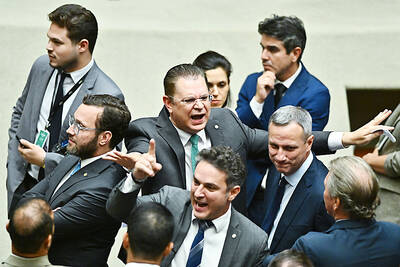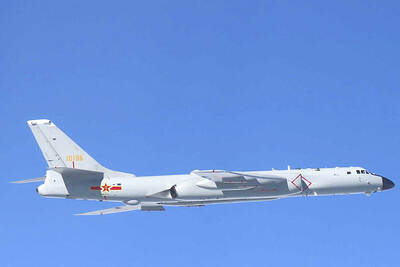For the seventh time since it took force in 1970, the world's nations gather yesterday to reassess how well the Nuclear Nonproliferation Treaty (NPT) is keeping the lid on man's most terrible weapons.
The delegations from almost 190 governments begin their month-long NPT review at a moment of growing nuclear fear and mistrust in the world.
North Korea, which declared its withdrawal from the treaty in 2003 and claims to have built nuclear bombs, said this weekend it was giving up negotiating over its weapons program with the administration of US President George W. Bush. It was another blow to the suspended six-party talks aimed at bringing Pyongyang back into the NPT.
Iran, meanwhile, said it will probably restart operations this week related to its disputed uranium enrichment program, which Washington contends is a cover for nuclear weapons plans.
Many other governments, on the other hand, complain the US and other big powers are moving too slowly toward scrapping their nuclear arms under the NPT.
UN Secretary-General Kofi Annan, the conference's leadoff speaker, has warned of a "crisis of confidence" in the nuclear pact.
In March, he proposed that states forbidden the weapons agree to toughened international inspection standards to verify they're not trying to make atom bombs. But he also said the nuclear powers, those whose weapons are provisionally accepted by the NPT, "must do more" to reduce their arsenals in an open, irreversible way.
Mohamad ElBaradei, head of the UN nuclear agency, who was also addressing the conference opening, has proposed nonproliferation measures in another area: putting nuclear fuel production under multilateral control, by regional or international bodies.
The "nuclear fuel cycle" is key to suspicions about Iran's intentions. The NPT's Article IV guarantees nonweapons states the right to peaceful nuclear technology, including uranium enrichment equipment to produce fuel for nuclear power plants. But that same technology, with further enrichment, can produce material for nuclear bombs.
The Tehran government, which denies it plans to convert uranium for weapons, is in off-and-on talks with European negotiators about shutting down its enrichment operations.
But the "Article IV loophole" is still expected to be a major issue before the NPT conference.
The 35-year-old nonproliferation treaty obliges 183 states to forswear nuclear arms in exchange for a pledge by five nuclear powers -- the US, Russia, Britain, France and China -- to move toward nuclear disarmament. Three other nuclear-armed states -- Israel, India and Pakistan -- remain outside the treaty.
Treaty reviews take place every five years, and at the 2000 conference the consensus final document committed the five NPT nuclear states to take 13 "practical steps" toward disarmament. Many non-nuclear states now want this year's conference conference to address what they say is the Bush administration's failure -- by rejecting the nuclear test-ban treaty, for example -- to meet that commitment.
For its part, the Bush administration says the conference should focus on what to do about Iran and North Korea. Pyongyang was able to withdraw from the treaty, and purportedly build atomic weapons, without penalty.
This clash of priorities stalled efforts to set a full agenda for the meeting. The conference president, Brazilian diplomat Sergio de Queiroz Duarte, said on Sunday the agenda may not be completed until several days into the sessions, but "everyone is working constructively in that direction."
To anti-nuclear protester Akemi Hatano, 66, marching with hundreds of others past the UN on Sunday, such disputes are trivial.
"I'm angry at any country that possesses nuclear weapons. They must all be abolished," said the tiny woman, who as a seven-year-old survived when 160,000 of her neighbors were killed or wounded in the US nuclear bombing of her hometown, Hiroshima.

PARLIAMENT CHAOS: Police forcibly removed Brazilian Deputy Glauber Braga after he called the legislation part of a ‘coup offensive’ and occupied the speaker’s chair Brazil’s lower house of Congress early yesterday approved a bill that could slash former Brazilian president Jair Bolsonaro’s prison sentence for plotting a coup, after efforts by a lawmaker to disrupt the proceedings sparked chaos in parliament. Bolsonaro has been serving a 27-year term since last month after his conviction for a scheme to stop Brazilian President Luiz Inacio Lula da Silva from taking office after the 2022 election. Lawmakers had been discussing a bill that would significantly reduce sentences for several crimes, including attempting a coup d’etat — opening up the prospect that Bolsonaro, 70, could have his sentence cut to

China yesterday held a low-key memorial ceremony for the 1937 Nanjing Massacre, with Chinese President Xi Jinping (習近平) not attending, despite a diplomatic crisis between Beijing and Tokyo over Taiwan. Beijing has raged at Tokyo since Japanese Prime Minister Sanae Takaichi last month said that a hypothetical Chinese attack on Taiwan could trigger a military response from Japan. China and Japan have long sparred over their painful history. China consistently reminds its people of the 1937 Nanjing Massacre, in which it says Japanese troops killed 300,000 people in what was then its capital. A post-World War II Allied tribunal put the death toll

A passerby could hear the cacophony from miles away in the Argentine capital, the unmistakable sound of 2,397 dogs barking — and breaking the unofficial world record for the largest-ever gathering of golden retrievers. Excitement pulsed through Bosques de Palermo, a sprawling park in Buenos Aires, as golden retriever-owners from all over Argentina transformed the park’s grassy expanse into a sea of bright yellow fur. Dog owners of all ages, their clothes covered in dog hair and stained with slobber, plopped down on picnic blankets with their beloved goldens to take in the surreal sight of so many other, exceptionally similar-looking ones.

‘UNWAVERING ALLIANCE’: The US Department of State said that China’s actions during military drills with Russia were not conducive to regional peace and stability The US on Tuesday criticized China over alleged radar deployments against Japanese military aircraft during a training exercise last week, while Tokyo and Seoul yesterday scrambled jets after Chinese and Russian military aircraft conducted joint patrols near the two countries. The incidents came after Japanese Prime Minister Sanae Takaichi triggered a dispute with Beijing last month with her remarks on how Tokyo might react to a hypothetical Chinese attack on Taiwan. “China’s actions are not conducive to regional peace and stability,” a US Department of State spokesperson said late on Tuesday, referring to the radar incident. “The US-Japan alliance is stronger and more